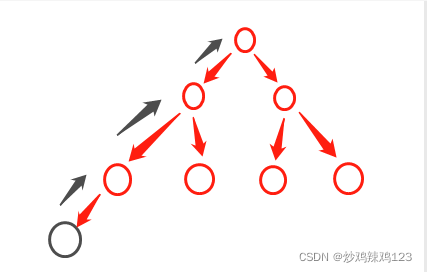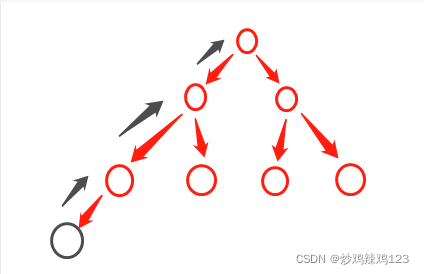Java如何实现二叉堆、大顶堆和小顶堆
导读:本文共5426字符,通常情况下阅读需要18分钟。同时您也可以点击右侧朗读,来听本文内容。按键盘←(左) →(右) 方向键可以翻页。
摘要: 什么是二叉堆二叉堆就是完全二叉树,或者是靠近完全二叉树结构的二叉树。在二叉树建树时采取前序建树就是建立的完全二叉树。也就是二叉堆。所以二叉堆的建堆过程理论上讲和前序建树一样。什么是大顶堆、小顶堆二叉堆本质上是一棵近完全的二叉树,那么大顶堆和小顶堆必然也是满足这个结构要求的。在此之上,大顶堆要求对于一个节点来说,它的左右节点都比它小;小顶堆要求对于一个节点来说,它... ...
目录
(为您整理了一些要点),点击可以直达。什么是二叉堆
二叉堆就是完全二叉树,或者是靠近完全二叉树结构的二叉树。在二叉树建树时采取前序建树就是建立的完全二叉树。也就是二叉堆。所以二叉堆的建堆过程理论上讲和前序建树一样。
什么是大顶堆、小顶堆
二叉堆本质上是一棵近完全的二叉树,那么大顶堆和小顶堆必然也是满足这个结构要求的。在此之上,大顶堆要求对于一个节点来说,它的左右节点都比它小;小顶堆要求对于一个节点来说,它的左右节点都比它大。
建堆
二叉堆建堆本质上和前序建堆差不多,只不过需要考虑的一点就是大小关系,这一点和二叉搜索树建树有点相似,所以可以得出结论,建树,本质上都是递归建树,只不过因为数据结构的大小要求不一样,需要的判断函数不一样,节点进入哪个位置也不一样。
大顶堆和小顶堆也分为稳定和不稳定的堆。稳定和不稳定指如果具备相同的值,那么他们的插入顺序应该和节点顺序一致。
程序实现
首先,定义出基本的堆结构
publicclassBinaryHeap{privateIntegervalue;privateBinaryHeapleftChild;privateBinaryHeaprightChild;}建堆过程与建二叉树过程一致
publicstaticBinaryHeapbuildHeap(BinaryHeapbinaryHeap,Integervalue){if(Objects.isNull(binaryHeap))binaryHeap=newBinaryHeap();if(Objects.isNull(binaryHeap.getValue())){binaryHeap.setValue(value);returnbinaryHeap;}if(Objects.isNull(binaryHeap.getLeftChild())){BinaryHeapbinaryHeap1=newBinaryHeap();binaryHeap1.setValue(value);binaryHeap.setLeftChild(binaryHeap1);}elseif(Objects.nonNull(binaryHeap.getLeftChild())){if(Objects.isNull(binaryHeap.getRightChild())){BinaryHeapbinaryHeap1=newBinaryHeap();binaryHeap1.setValue(value);binaryHeap.setRightChild(binaryHeap1);}else{//TODO:2022/1/14左右节点两种都不为nullif(checkNull(binaryHeap.getLeftChild()))buildHeap(binaryHeap.getLeftChild(),value);elseif(checkNull(binaryHeap.getRightChild()))buildHeap(binaryHeap.getRightChild(),value);elsebuildHeap(binaryHeap.getLeftChild(),value);}}returnbinaryHeap;}主要原理就是如果当前节点的左节点为空,则把当前值放到左节点,如果左节点不为空,右节点为空,则把值放到右节点。如果左右节点都不为空,就将建树过程转移到下一层,如果左节点有为空的子节点,就转移给左节点,如果左节点没有为空的子节点,且右节点有为空的子节点,那么转移给右节点。如果左右节点都没有为空的子节点,那么也转移给左节点。
以序列2,3,4,5,9,6,8,7为例,按照该算法建立出来的二叉堆结构如下:
{"value":2,"left_child":{"value":3,"left_child":{"value":4,"left_child":{"value":8,"left_child":null,"right_child":null},"right_child":{"value":7,"left_child":null,"right_child":null}},"right_child":{"value":5,"left_child":null,"right_child":null}},"right_child":{"value":1,"left_child":{"value":9,"left_child":null,"right_child":null},"right_child":{"value":6,"left_child":null,"right_child":null}}}建立大顶堆
大顶堆在建堆的基础上,有一个要求,根节点比左右子树的任何节点的值都大。那么建树的过程可以分为两步,对于每一个值,首先按照建树过程,会到二叉堆的最底部,然后通过不断的让自己与自己的根节点做比较,如果自己大于根节点,就交换自己与根节点的位置,递归回溯即可。
逻辑过程

假设现在红色节点组成的已经是一个大顶堆,现在新增了一个节点到这个二叉堆中,而且是比任意节点都大,那么黑色箭头将是该节点的行动路线,它会反复与父级比较,如果大于父级,则交换和父级的关系。
程序实现
publicstaticBinaryHeapup(BinaryHeapfather){if(Objects.nonNull(father.getLeftChild())){if(father.getValue()<father.getLeftChild().getValue()){intc=father.getValue();father.setValue(father.getLeftChild().getValue());father.getLeftChild().setValue(c);}up(father.getLeftChild());}if(Objects.nonNull(father.getRightChild())){if(father.getValue()<father.getRightChild().getValue()){intc=father.getValue();father.setValue(father.getRightChild().getValue());father.getRightChild().setValue(c);}up(father.getRightChild());}returnfather;}该方法放在普通建树方法之后,就是大顶堆的建树方法了,总的方法如下:
publicstaticBinaryHeapbigPush(BinaryHeapbinaryHeap,Integervalue){binaryHeap=buildHeap(binaryHeap,value);up(binaryHeap);returnbinaryHeap;}还是以序列2,3,4,5,9,6,8,7为例,按照该算法建立出来的大顶堆结构如下:
{"value":9,"left_child":{"value":8,"left_child":{"value":7,"left_child":{"value":2,"left_child":null,"right_child":null},"right_child":{"value":4,"left_child":null,"right_child":null}},"right_child":{"value":3,"left_child":null,"right_child":null}},"right_child":{"value":6,"left_child":{"value":1,"left_child":null,"right_child":null},"right_child":{"value":5,"left_child":null,"right_child":null}}}建立小顶堆
小顶堆与大顶堆类似
逻辑过程

过程与大顶堆一致,不过此时是比父级小就和父级交换。
程序实现
publicstaticBinaryHeapdown(BinaryHeapfather){if(Objects.nonNull(father.getLeftChild())){if(father.getValue()>father.getLeftChild().getValue()){intc=father.getValue();father.setValue(father.getLeftChild().getValue());father.getLeftChild().setValue(c);}down(father.getLeftChild());}if(Objects.nonNull(father.getRightChild())){if(father.getValue()>father.getRightChild().getValue()){intc=father.getValue();father.setValue(father.getRightChild().getValue());father.getRightChild().setValue(c);}down(father.getRightChild());}returnfather;}这个是向下走的过程,最终代码为:
publicstaticBinaryHeapsmallPush(BinaryHeapbinaryHeap,Integervalue){binaryHeap=buildHeap(binaryHeap,value);down(binaryHeap);returnbinaryHeap;}以序列2,3,4,5,9,6,8,7为例,按照该算法建立出来的小顶堆结构如下:
{"value":1,"left_child":{"value":3,"left_child":{"value":4,"left_child":{"value":8,"left_child":null,"right_child":null},"right_child":{"value":7,"left_child":null,"right_child":null}},"right_child":{"value":5,"left_child":null,"right_child":null}},"right_child":{"value":2,"left_child":{"value":9,"left_child":null,"right_child":null},"right_child":{"value":6,"left_child":null,"right_child":null}}}从堆顶取数据并重构大小顶堆
publicstaticIntegerbigPop(BinaryHeapbinaryHeap){Integerval=binaryHeap.getValue();if(binaryHeap.getLeftChild().getValue()>=binaryHeap.getRightChild().getValue()){binaryHeap.setValue(binaryHeap.getLeftChild().getValue());BinaryHeapbinaryHeap1=mergeTree(binaryHeap.getLeftChild().getLeftChild(),binaryHeap.getLeftChild().getRightChild());up(binaryHeap1);binaryHeap.setLeftChild(binaryHeap1);}else{binaryHeap.setValue(binaryHeap.getRightChild().getValue());BinaryHeapbinaryHeap1=mergeTree(binaryHeap.getRightChild().getLeftChild(),binaryHeap.getRightChild().getRightChild());up(binaryHeap1);binaryHeap.setRightChild(binaryHeap1);}returnval;}publicstaticIntegersmallPop(BinaryHeapbinaryHeap){Integerval=binaryHeap.getValue();if(binaryHeap.getLeftChild().getValue()<=binaryHeap.getRightChild().getValue()){binaryHeap.setValue(binaryHeap.getLeftChild().getValue());BinaryHeapbinaryHeap1=mergeTree(binaryHeap.getLeftChild().getLeftChild(),binaryHeap.getLeftChild().getRightChild());down(binaryHeap1);binaryHeap.setLeftChild(binaryHeap1);}else{binaryHeap.setValue(binaryHeap.getRightChild().getValue());BinaryHeapbinaryHeap1=mergeTree(binaryHeap.getRightChild().getLeftChild(),binaryHeap.getRightChild().getRightChild());down(binaryHeap1);binaryHeap.setRightChild(binaryHeap1);}returnval;}取出来之后,需要重新调用down或者up函数。以构建小顶堆,取出五次后的结果
publicstaticvoidmain(String[]args){int[]a=newint[]{2,3,1,4,5,9,6,8,7};BinaryHeapbinaryHeap=newBinaryHeap();for(inti=0;i<a.length;i++){binaryHeap=smallPush(binaryHeap,a[i]);}System.out.println(Json.toJson(smallPop(binaryHeap)));System.out.println(Json.toJson(smallPop(binaryHeap)));System.out.println(Json.toJson(smallPop(binaryHeap)));System.out.println(Json.toJson(smallPop(binaryHeap)));System.out.println(Json.toJson(smallPop(binaryHeap)));System.out.println(Json.toJson(binaryHeap));}取完后的小顶堆为:
{"value":6,"left_child":{"value":7,"left_child":{"value":8,"left_child":null,"right_child":null},"right_child":null},"right_child":{"value":9,"left_child":null,"right_child":null}} </div> <div class="zixun-tj-product adv-bottom"></div> </div> </div> <div class="prve-next-news">Java如何实现二叉堆、大顶堆和小顶堆的详细内容,希望对您有所帮助,信息来源于网络。